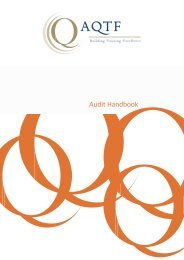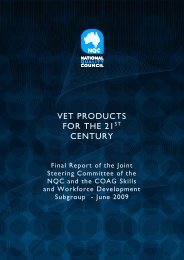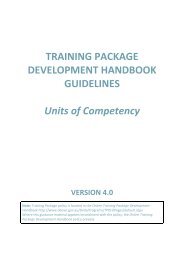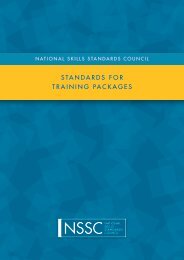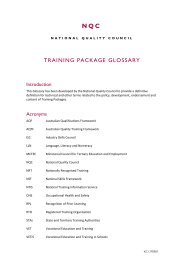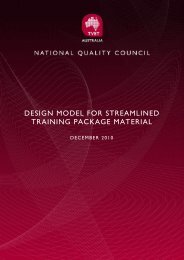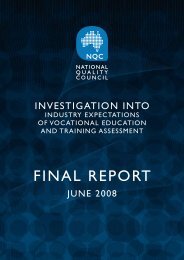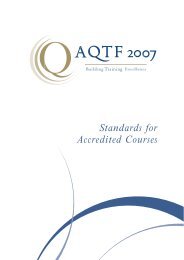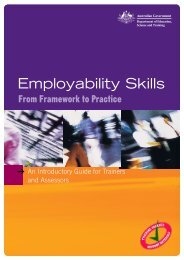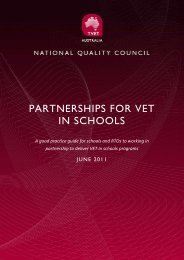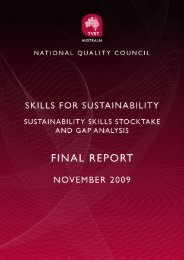Training package development handbook guidelines
Training package development handbook guidelines
Training package development handbook guidelines
Create successful ePaper yourself
Turn your PDF publications into a flip-book with our unique Google optimized e-Paper software.
Individual units of competency are not aligned to the AQF; alignment occurs when a group of units<br />
of competency equate to a viable AQF qualification or qualifications. In arriving at an AQF alignment<br />
for groups of units of competency, developers should consult with the relevant industry about the<br />
appropriate use of individual units, including any pre‐requisite relationships.<br />
When referring to units of competency in the <strong>Training</strong> Package Qualification Framework, reference<br />
should be to the specific AQF qualification title such as Certificate I, Certificate II and so on—not to<br />
‘AQF levels’. The AQF has qualifications used in the schools sector sit below Certificate I—therefore<br />
any reference to ‘AQF levels’, for example calling Certificate I ‘Level I’, is potentially confusing and<br />
inaccurate.<br />
There is no requirement that the full range of possible VET sector qualifications should be available<br />
in one <strong>Training</strong> Package. However, developers should consider including Certificate I or II<br />
qualifications to provide entry to the industry and meaningful pathways to further training and<br />
employment. This is particularly important for groups and individuals who may have been<br />
disadvantaged in their access to vocational education and training.<br />
A number of factors will contribute to the ‘user friendliness’ of the explanation of the qualifications<br />
framework for readers of the <strong>Training</strong> Package:<br />
• grouping all of the units of competency that make up a qualification together wherever practical<br />
• clearly stating the number of units required to achieve a particular qualification, avoiding terms<br />
which can be interpreted in various ways, for example maximum or minimum number of units<br />
• using wherever possible the terms listed in the packaging models advice in this document rather<br />
than developing new terms which may confuse some users<br />
• providing a well presented diagram or table showing the relationship between all the identified<br />
qualifications in the <strong>Training</strong> Package and if appropriate any relationships with qualifications<br />
from other endorsed <strong>Training</strong> Packages.<br />
4. Coding and titling for qualifications<br />
<strong>Training</strong> Package qualification codes and titles must comply with the policies in the Online <strong>Training</strong><br />
Package Development Handbook. Each <strong>Training</strong> Package qualification has a unique eight‐character<br />
code. An example is provided below.<br />
AQF<br />
level<br />
}<br />
Year of<br />
endorsement<br />
}<br />
AUM30108 Certificate III in Automotive Manufacturing<br />
}<br />
This identifies the<br />
<strong>Training</strong> Package<br />
(in this case<br />
Automotive)<br />
}<br />
Position in<br />
qualification<br />
sequence<br />
4.1 Coding and titling maintenance for qualifications<br />
If qualifications are added to a <strong>Training</strong> Package during its period of endorsement, developers should<br />
consult the Online <strong>Training</strong> Package Development Handbook.<br />
GuidelinesQualFrameworks_V3_June 2010 V3 June 2010 Page 10 of 28



